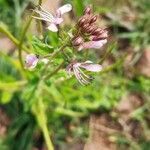Annual herb, erect or spreading, up to 1 m. tall, very variable.. Stem abundantly covered with rather short glandular and longer eglandular hairs.. Leaves simple, very variable; blade usually lanceolate or oblong, more rarely ovate or linear-lanceolate, 1.4–4–7 cm. long, 0.75–1–3 cm. wide, pubescent on both surfaces with hairs like those of the stem.. Inflorescence up to 30 cm. long.. Sepals 3–5 mm. long.. Petals pink or mauve (or ? sometimes yellow).. Stamens 6.. Capsules 2.5–8 cm. long, sessile or borne on a gynophore up to 2(–7) mm. long, abundantly covered with glandular and eglandular hairs.. Seeds up to 1.8 mm. in diameter, brown with fine longitudinal striations and very low transverse ridges.. Fig. 2/19, p. 10.
Annual herb, up to 0.5 m high, erect. Stems striate, pubescent. Leaves simple, petiolate, pubescent; linear-lanceolate to oblong-ovate, margins entire. Inflorescence a terminal raceme. Sepals linear-lanceolate, pubescent. Petals pink to pale mauve with a transverse yellow band outlined in purple on the upper two, spathulate. Stamens 6. Ovary almost sessile, puberulous. Fruit a narrowly linear capsule, straight or slightly curved, spreading. Seeds brown to dark brown, almost circular in outline, somewhat flattened, transversely ridged.
Annual herb, up to 500 mm high. Stems erect; pubescent, often with glandular hairs. Leaves all simple petiolate; blade narrowly ovate to oblong-ovate, 20-70 x 3-25 mm, base truncate or rounded, apex acute; petiole up to 40 mm long. Flowers: stamens all fertile; petals spathulate, 3-9 mm long, pink to pale mauve, rarely white, two upper petals with a transverse yellow band outlined in purple; Nov.-May. Fruit 50-110 x 3 mm; seeds brown to dark brown, ± circular, ± 2 mm in diameter, transversely ridged.
A small annual herb. It is erect and hairy. It grows 30-60 cm high. It can be spreading. The leaves are simple and undivided. They are 2.5-8 cm long and narrow. The flowers are pink and purple. The pods are long and thin. They are 5-11 mm long by 3 mm wide. They contain several small flat seeds.
Leaves petiolate; lamina 2–7.5 x 0.3–2.5 cm., linear-lanceolate to oblong, acute or subacute at the apex, rounded or slightly cordate at the base, entire, pubescent on both sides with hairs often glandular; petiole up to 3 cm. long (often less), pubescent.
Capsule up to c. 10 cm. long, narrowly linear, puberulous, straight or slightly curved, narrowed to both ends with up to 6 longitudinal, anastomosing nerves on each valve; gynophore very short, up to 2 mm. long; style persistent.
Inflorescence a raceme, elongating in fruit; bracts sessile, similar to the leaves but slightly more cordate at the base and smaller; pedicels slender, glandular-pubescent, up to 1 cm. long, elongating in fruit up to 2 cm.
Petals pale rose or mauve, with a yellow band bordered with purple on the upper two, rarely white, lamina up to 9 mm. long, oblong, rounded at the apex, narrowing into a basal claw somewhat shorter than the lamina.
Erect annual herb, up to 500 mm tall. Leaves all simple. Two upper petals with transverse yellow band, outlined in purple. Flowers pink to pale mauve.
Seeds dark brown, c. 1.8 mm. in diam., radially ridged with the ridges bearing minute puberulous incrustations visible only at a x 40 magnification.
Sepals up to 5 mm. long, linear-lanceolate, caudate or long-acuminate at the apex, pubescent outside with some hairs glandular.
Stamens 6, unequal, all fertile; filaments slender, up to 1 cm. long, glabrous; anthers oblong, c. 1.5 mm. long.
Ovary almost sessile, c. 1.5 mm. long, linear-oblong, puberulous; style very short; stigma capitate.
Erect annual herb to 0.6 m. tall, usually branched.
Stems pubescent with some hairs gland-tipped.

